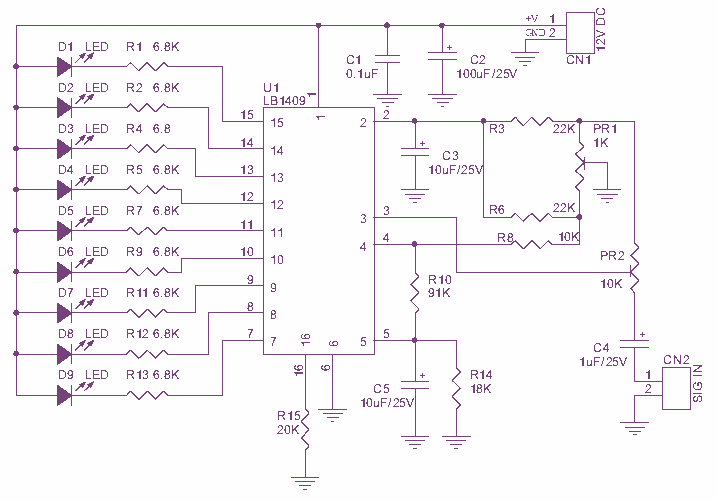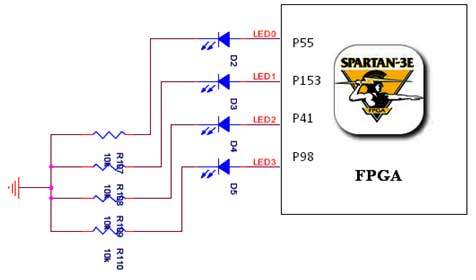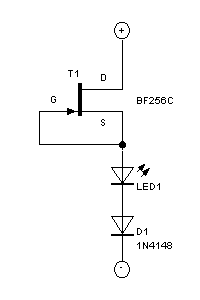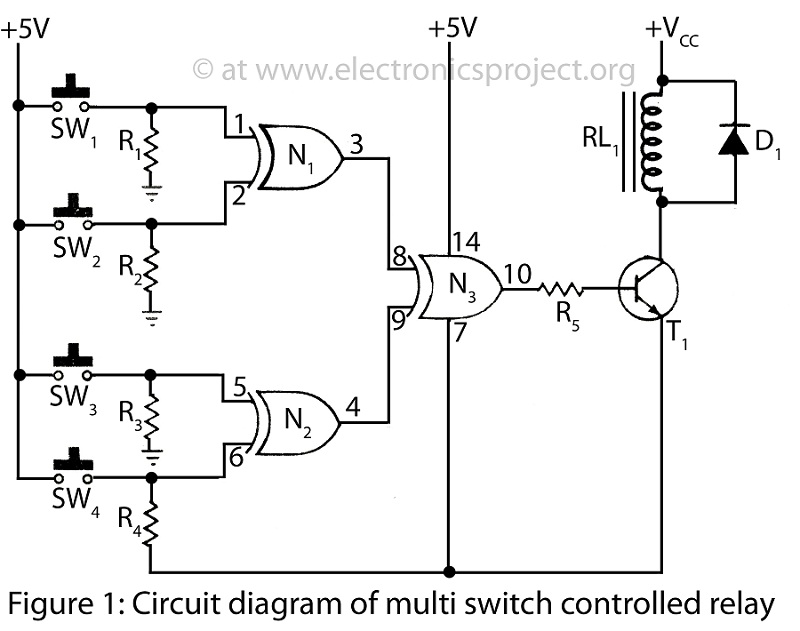
9 LED VU meter

This simple and easy to make circuit is a 5 LED VU Meter based on LB1409 IC from SANYO, which will indicates the volume level of the audio signal it senses. SUPPLY 12V DC @ 50mA. PR1 REF SET. PR2 AUDIO LEVEL SET
The circuit described is a 5 LED VU Meter utilizing the LB1409 integrated circuit from SANYO, designed to visually represent the amplitude of an audio signal. The circuit operates with a supply voltage of 12V DC and consumes approximately 50mA of current.
The LB1409 IC serves as the core component, which processes the incoming audio signal and drives the LEDs accordingly. The circuit includes two potentiometers: PR1, which is used to set the reference level, and PR2, which adjusts the sensitivity of the audio input.
When an audio signal is applied, the LB1409 analyzes the signal's amplitude and activates the corresponding number of LEDs based on the detected volume level. The first LED lights up at the lowest volume threshold, with each subsequent LED illuminating as the volume increases, providing a clear visual indication of the audio level.
To construct this circuit, the following components are necessary:
- LB1409 IC
- Five LEDs (preferably of the same color for uniformity)
- Two potentiometers (PR1 and PR2)
- Resistors to limit the current through the LEDs
- A power supply capable of providing 12V DC
- Additional passive components such as capacitors for smoothing and filtering the audio signal as needed.
The layout should ensure that the audio input is connected to the appropriate pins of the LB1409, and the output pins are connected to each of the LEDs through current-limiting resistors. Proper grounding and decoupling capacitors should be placed near the power supply pins of the IC to ensure stable operation.
This circuit can be used in various audio applications, including amplifiers and mixers, to provide a visual representation of audio levels, aiding in sound engineering and mixing tasks.This simple and easy to make circuit is a 5 LED VU Meter based on LB1409 IC from SANYO, which will indicates the volume level of the audio signal it senses. SUPPLY 12V DC @ 50mA. PR1 REF SET. PR2 AUDIO LEVEL SET 🔗 External reference
The circuit described is a 5 LED VU Meter utilizing the LB1409 integrated circuit from SANYO, designed to visually represent the amplitude of an audio signal. The circuit operates with a supply voltage of 12V DC and consumes approximately 50mA of current.
The LB1409 IC serves as the core component, which processes the incoming audio signal and drives the LEDs accordingly. The circuit includes two potentiometers: PR1, which is used to set the reference level, and PR2, which adjusts the sensitivity of the audio input.
When an audio signal is applied, the LB1409 analyzes the signal's amplitude and activates the corresponding number of LEDs based on the detected volume level. The first LED lights up at the lowest volume threshold, with each subsequent LED illuminating as the volume increases, providing a clear visual indication of the audio level.
To construct this circuit, the following components are necessary:
- LB1409 IC
- Five LEDs (preferably of the same color for uniformity)
- Two potentiometers (PR1 and PR2)
- Resistors to limit the current through the LEDs
- A power supply capable of providing 12V DC
- Additional passive components such as capacitors for smoothing and filtering the audio signal as needed.
The layout should ensure that the audio input is connected to the appropriate pins of the LB1409, and the output pins are connected to each of the LEDs through current-limiting resistors. Proper grounding and decoupling capacitors should be placed near the power supply pins of the IC to ensure stable operation.
This circuit can be used in various audio applications, including amplifiers and mixers, to provide a visual representation of audio levels, aiding in sound engineering and mixing tasks.This simple and easy to make circuit is a 5 LED VU Meter based on LB1409 IC from SANYO, which will indicates the volume level of the audio signal it senses. SUPPLY 12V DC @ 50mA. PR1 REF SET. PR2 AUDIO LEVEL SET 🔗 External reference





